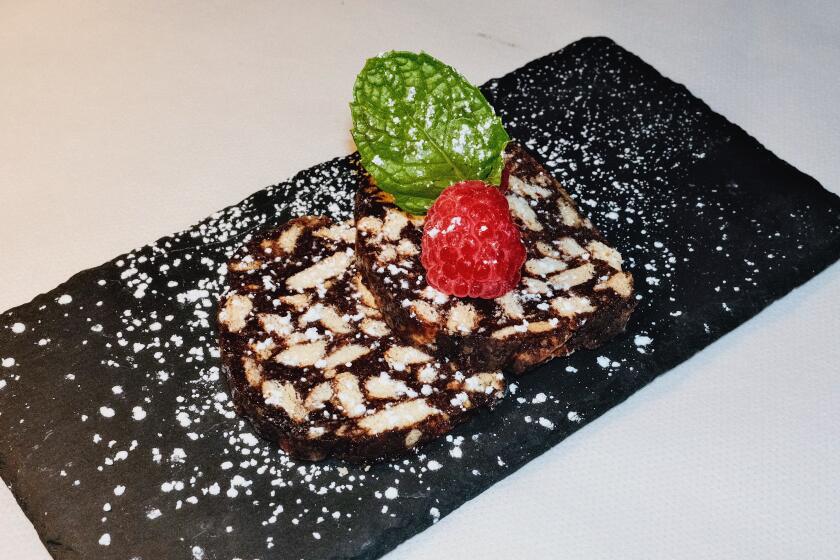Upside-Down Cake With Mixed Dried Fruits

- Share via
Deborah Madison is known for great vegetarian cookbooks, beginning with the landmark “Greens Cookbook,” which she wrote in 1987 as the founding chef of Greens Restaurant in San Francisco.
Clearly this is a woman who knows her produce. Madison’s new book, “Local Flavors” (Broadway Books: $39.95), is based on her study of farmers markets across the country and her experiences running one in Santa Fe, N.M., where she lives.
What may surprise Madison’s fans is that this is not a vegetarian book. It includes a few meat and seafood recipes because some farmers markets sell these products and because, as Madison says of her own meat-eating at the end of her introduction, “I do enjoy it occasionally.”
Still, the focus is fresh, seasonal produce, and Madison rightly praises the way growers have enhanced our tables with quality produce and uncommon varieties. “This is food that tastes so good that little has to be done to it in the kitchen,” she writes, and proves her approach with recipes that tend toward simplicity. The idea is to enhance natural, fresh flavors.
But sometimes that good philosophy leads to frustration in the kitchen. Some dishes have less flavor than one expects. And some of the recipes call for produce that is so specialized that even readers who shop at farmers markets may not find it. Supermarket shoppers will surely have to substitute, which defeats the book’s purpose, or else stick to the dishes with common ingredients.
Madison’s recipes meander through the seasons and through produce groups without any rigid order. Soups, salads, pizza, pasta and seared, roasted and braised vegetables are lumped together in the first chapter, on greens.
Five recipes, tested at random, yielded mixed results. An upside-down cake topped with dried fruits was a real winner, the sort of recipe you make again and again. Moist and buttery with perfectly tender fruit, it would be a wonderful Thanksgiving dessert--but is hard to resist even in summer.
Roasted peppers and tomatoes baked with herbs and capers was beautiful but bland. Roasted asparagus with citrus butter was another timid dish, but it looked stunning on the plate when made with blood oranges, as Madison suggests.
The recipe for braised broccoli with olives lacked clarity. Just what are “small heads” of broccoli? Individual stalks? A bunch? The recipe calls for an onion that is sauteed with chopped garlic and marjoram. One assumes that the onion is chopped first. Making educated guesses produced a good dish, nevertheless.
Corn pudding was handsome to look at, but it curdled as it baked and was too crumbly and dry to be called a pudding. It needed less cooking time than the recipe specified. (This was true also of the upside-down cake. One wonders if these dishes were tested at Santa Fe’s high altitude and therefore required more cooking time than at sea level in Los Angeles.)
The beautiful photographs and compelling discoveries make you want to follow in Madison’s footsteps. But she never lists the markets she visited, and only loosely connects some of the recipes to those she does mention.
These fresh, folksy markets supplied the format for the book, but where exactly are they, and when do they take place?
On the last page, Madison mentions a USDA directory for farmers markets, but where is her own personalized guide?
Madison has avid fans, and justly so. But this book may disappoint even some of them.
Fruit and topping
Place the fruit in a saucepan, cover with water and bring to a boil. Simmer, partially covered, until the fruit is plump and soft, about 30 minutes. Drain and set aside.
Melt the butter in a 10-inch cast-iron skillet, then whisk in the sugar. When it has melted, turn off the heat and allow the syrup to settle evenly over the bottom. Arrange the fruits attractively over the top, the cut sides facing up. If some pieces are very large, you might cut them into halves or quarters so that the cake will be easy to slice.
Cake
Heat the oven to 375 degrees.
Beat the butter with the sugar until light and fluffy, then add the vanilla and almond extracts and the eggs, one at a time, and beat until thoroughly smooth. Scrape down the bowl between additions, then add the buttermilk.
In another bowl, sift or whisk the flour, baking soda, baking powder and salt together so that they are combined evenly. With the mixer on low, add them to the batter in 3 or 4 separate additions.
Spoon the batter over the fruit, then bake in the center of the oven until the cake is golden and starting to pull away from the sides, about 25 to 35 minutes. Cool for 5 minutes, then place a serving plate over the skillet, grasp both together, and flip them over. Remove the skillet. Serve while still a bit warm or when fully cooled.
Get our Cooking newsletter
Get a taste of Los Angeles — and the world — with recipes and kitchen tricks from the L.A. Times’ Cooking newsletter.
You may occasionally receive promotional content from the Los Angeles Times.















